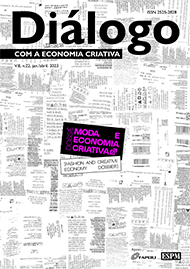Approaching the creative process as a complex adaptive system
DOI:
https://doi.org/10.22398/2525-2828.822117-131Keywords:
Footwear design, Complex adaptive systems, Creative process, Creative industryAbstract
This article proposed as a general objective to understand whether creativity, in a process approach, can be understood as a complex adaptive system, in the perception of professionals in creative areas, regarding the processes inherent in the management of fashion products, who work in companies in the leather-footwear sector located in the region of Vale dos Sinos. Seven semi-structured interviews were carried out with the target audience, from five companies, as detailed in section three. Regarding the approaches brought by the contributions of complex adaptive systems (CAS), which find similar characteristics in creative and innovative organizations, it was possible to conclude that there are opportunities for the researched environments to explore, in more depth, such approaches, which understand that the Organizations are not just the sum of their components (agents), but also the result of the intricate relationship between these components. Recognizing the complexity inherent to the creative process of organizations, understanding the interrelationships, and the interdependence between the subjects and elements involved in these interactions, can contribute to rethinking new alternatives and management strategies.
References
AMABILE, T.M. A model of creativity and innovation in organizations. Research in Organizational Behavior, v. 10, n. 1, p. 123-167, 1988.
AMABILE, T.M.; BARSADE, S.G.; MUELLER, J.S.; STAW, B.M. Affect and creativity at work. Administrative Science Quarterly, v. 50, n. 3, p. 367-403, 2005. https://doi.org/10.2189/asqu.2005.50.3.367
ASSOCIAÇÃO BRASILEIRA DAS INDÚSTRIAS DE CALÇADOS (ABICALÇADOS). Relatório Anual 2021. Novo Hamburgo: Abicalçados, 2018. Disponível em: https://abicalcados.com.br/publicacoes/relatorio-anual. Acesso em: 10 ago. 2022.
BAUER, M.W.; GASKELL, G. Pesquisa qualitativa com texto, imagem e som: um manual prático. Rio de Janeiro: Vozes, 2002.
BAXTER, M. Projeto de produto: guia prático para o design de novos produtos. São Paulo: Blucher, 1998.
CANIËLS, M.; RIETZSCHEL, E. Organizing creativity: Creativity and innovation under constraints. Creativity and Innovation Management, v. 24, n. 2, p. 184-196, 2015. https://doi.org/10.1111/caim.12123
CONSELHO REGIONAL DE DESENVOLVIMENTO DO VALE DO RIO DOS SINOS (CONSINOS). Plano Estratégico de Desenvolvimento da Região do Vale do Sinos (2015-2030). Novo Hamburgo: Consinos, 2017.
COSTA, E.F. Comprador de Moda. São Paulo: Editora Senac, 2013.
PONCHIROLLI, O. A teoria da complexidade e as organizações. Revista Diálogo Educacional, Curitiba, v. 7, n. 22, p. 81-100, 2007.
RECH, S.R. Moda: por um fio de qualidade. Florianópolis: Editora da Udesc, 2002.
SAYEG, C.M. Gerência de produtos de moda. São Paulo: Editora Senac, 2015.
SCHNEIDER, S. O mercado de trabalho da indústria coureiro-calçadista do Rio Grande do Sul: formação histórica e desenvolvimento. In: COSTA, A.; PASSOS, M.C. (org.). A indústria calçadista no Rio Grande do Sul. São Leopoldo: Editora Unisinos, 2004. p. 25-49.
STACEY, R.D. Complexity and creativity in organizations. [S. l.]: Berrett-Koehler Publishers, 1996.
STACEY, R.D.; GRIFFIN, D. Introduction, leading in a complex world. In: GRIFFIN, D.; STACEY R. (org.). Complexity and the experience of leading organizations. Londres: Routledge, 2005. p. 14-29.
STERNBERG, R.J. The nature of creativity. Creativity Research Journal, v. 18, n. 1, p. 87-98, 2006. https://doi.org/10.1207/s15326934crj1801_10
TIDD, J.; BESSANT, J.; PAVITT, K. Gestão da inovação. Porto Alegre: Bookman, 2008.
TREPTOW, D. Inventando moda: planejamento de coleção. São Paulo: [s.n.], 2013.
Downloads
Published
How to Cite
Issue
Section
License
Copyright (c) 2025 Lenice Eli Lunkes Scapato, Dusan Schreiber, Vanessa Theis

This work is licensed under a Creative Commons Attribution-NonCommercial-NoDerivatives 4.0 International License.
The copyright for articles published in this journal belongs to the author, with first publication rights to the journal.
We emphasize that the responsibility for the articles is exclusive to the author(s) and does not necessarily reflect the opinion of the Editors or ESPM.








